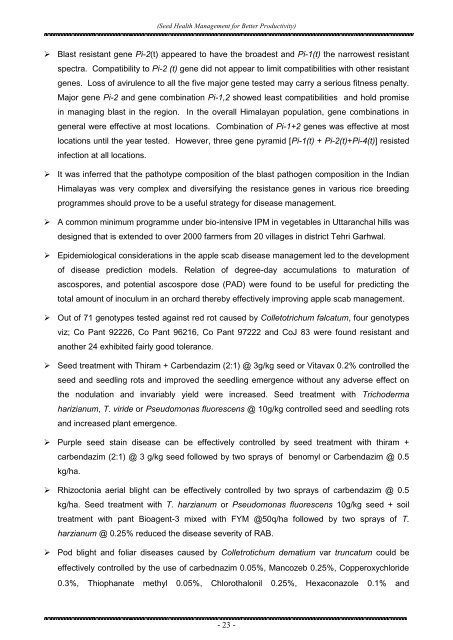Seed Health Management for Better Productivity - Govind Ballabh ...
Seed Health Management for Better Productivity - Govind Ballabh ...
Seed Health Management for Better Productivity - Govind Ballabh ...
Create successful ePaper yourself
Turn your PDF publications into a flip-book with our unique Google optimized e-Paper software.
(<strong>Seed</strong> <strong>Health</strong> <strong>Management</strong> <strong>for</strong> <strong>Better</strong> <strong>Productivity</strong>)‣ Blast resistant gene Pi-2(t) appeared to have the broadest and Pi-1(t) the narrowest resistantspectra. Compatibility to Pi-2 (t) gene did not appear to limit compatibilities with other resistantgenes. Loss of avirulence to all the five major gene tested may carry a serious fitness penalty.Major gene Pi-2 and gene combination Pi-1,2 showed least compatibilities and hold promisein managing blast in the region. In the overall Himalayan population, gene combinations ingeneral were effective at most locations. Combination of Pi-1+2 genes was effective at mostlocations until the year tested. However, three gene pyramid [Pi-1(t) + Pi-2(t)+Pi-4(t)] resistedinfection at all locations.‣ It was inferred that the pathotype composition of the blast pathogen composition in the IndianHimalayas was very complex and diversifying the resistance genes in various rice breedingprogrammes should prove to be a useful strategy <strong>for</strong> disease management.‣ A common minimum programme under bio-intensive IPM in vegetables in Uttaranchal hills wasdesigned that is extended to over 2000 farmers from 20 villages in district Tehri Garhwal.‣ Epidemiological considerations in the apple scab disease management led to the developmentof disease prediction models. Relation of degree-day accumulations to maturation ofascospores, and potential ascospore dose (PAD) were found to be useful <strong>for</strong> predicting thetotal amount of inoculum in an orchard thereby effectively improving apple scab management.‣ Out of 71 genotypes tested against red rot caused by Colletotrichum falcatum, four genotypesviz; Co Pant 92226, Co Pant 96216, Co Pant 97222 and CoJ 83 were found resistant andanother 24 exhibited fairly good tolerance.‣ <strong>Seed</strong> treatment with Thiram + Carbendazim (2:1) @ 3g/kg seed or Vitavax 0.2% controlled theseed and seedling rots and improved the seedling emergence without any adverse effect onthe nodulation and invariably yield were increased. <strong>Seed</strong> treatment with Trichodermaharizianum, T. viride or Pseudomonas fluorescens @ 10g/kg controlled seed and seedling rotsand increased plant emergence.‣ Purple seed stain disease can be effectively controlled by seed treatment with thiram +carbendazim (2:1) @ 3 g/kg seed followed by two sprays of benomyl or Carbendazim @ 0.5kg/ha.‣ Rhizoctonia aerial blight can be effectively controlled by two sprays of carbendazim @ 0.5kg/ha. <strong>Seed</strong> treatment with T. harzianum or Pseudomonas fluorescens 10g/kg seed + soiltreatment with pant Bioagent-3 mixed with FYM @50q/ha followed by two sprays of T.harzianum @ 0.25% reduced the disease severity of RAB.‣ Pod blight and foliar diseases caused by Colletrotichum dematium var truncatum could beeffectively controlled by the use of carbednazim 0.05%, Mancozeb 0.25%, Copperoxychloride0.3%, Thiophanate methyl 0.05%, Chlorothalonil 0.25%, Hexaconazole 0.1% and- 23 -
















